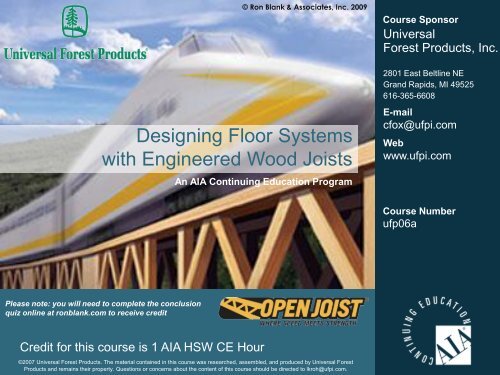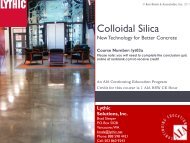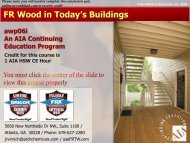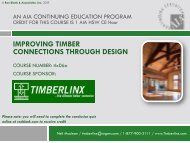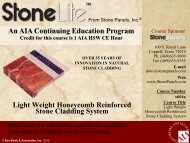Designing Floor Systems with Engineered Wood Joists - Ron Blank ...
Designing Floor Systems with Engineered Wood Joists - Ron Blank ...
Designing Floor Systems with Engineered Wood Joists - Ron Blank ...
You also want an ePaper? Increase the reach of your titles
YUMPU automatically turns print PDFs into web optimized ePapers that Google loves.
© <strong>Ron</strong> <strong>Blank</strong> & Associates, Inc. 2009<br />
<strong>Designing</strong> <strong>Floor</strong> <strong>Systems</strong><br />
<strong>with</strong> <strong>Engineered</strong> <strong>Wood</strong> <strong>Joists</strong><br />
An AIA Continuing Education Program<br />
Course Sponsor<br />
Universal<br />
Forest Products, Inc.<br />
2801 East Beltline NE<br />
Grand Rapids, MI 49525<br />
616-365-6608<br />
E-mail<br />
cfox@ufpi.com<br />
Web<br />
www.ufpi.com<br />
Course Number<br />
ufp06a<br />
<strong>Designing</strong> <strong>Floor</strong> <strong>Systems</strong> <strong>with</strong> <strong>Engineered</strong> <strong>Wood</strong> <strong>Joists</strong><br />
Please note: you will need to complete the conclusion<br />
quiz online at ronblank.com to receive credit<br />
Credit for this course is 1 AIA HSW CE Hour<br />
©2007 Universal Forest Products. The material contained in this course was researched, assembled, and produced by Universal Forest<br />
Products and remains their property. Questions or concerns about the content of this course should be directed to lkroh@ufpi.com.
An American Institute of Architects (AIA)<br />
Continuing Education program<br />
Approved Promotional Statement:<br />
<strong>Ron</strong> <strong>Blank</strong> & Associates, Inc. is a registered provider <strong>with</strong> The American<br />
Institute of Architects Continuing Education System. Credit earned upon<br />
completion of this program will be reported to CES Records for AIA members.<br />
Certificates of Completion are available for all course participants upon<br />
completion of the course conclusion quiz <strong>with</strong> +80%.<br />
Please view the following slide for more information on Certificates of<br />
Completion through RBA<br />
This program is registered <strong>with</strong> the AIA/CES for continuing professional<br />
education. As such, it does not include content that may be deemed or construed<br />
to be an approval or endorsement by the AIA or <strong>Ron</strong> <strong>Blank</strong> & Associates, Inc. of<br />
any material of construction or any method or manner of handling, using,<br />
distributing, or dealing in any material or product.
An American Institute of Architects (AIA)<br />
Continuing Education program<br />
• Course Format: This is a structured, web-based, self study course <strong>with</strong> a<br />
final exam.<br />
• Course Credit: 1 AIA Health Safety & Welfare (HSW) CE Hour<br />
• Completion Certificate: A confirmation is sent to you by email and you can<br />
print one upon successful completion of a course or from your<br />
<strong>Ron</strong><strong>Blank</strong>.com transcript. If you have any difficulties printing or receiving<br />
your Certificate please send requests to certificate@ronblank.com<br />
Design professionals, please remember to print or save your certificate of<br />
completion after successfully completing a course conclusion quiz. Email<br />
confirmations will be sent to the email address you have provided in your<br />
<strong>Ron</strong><strong>Blank</strong>.com account.<br />
Please note: you will need to complete the conclusion quiz<br />
online at ronblank.com to receive credit
Course Description<br />
There are many factors to consider when designing a floor system<br />
<strong>with</strong> engineered wood joists. Review the design strategies, code<br />
requirements, different types of engineered floor components, and<br />
their capabilities and limitations.
Course Objectives<br />
Upon completion of this course the design professional will be able to:<br />
List the factors to consider when designing floor systems<br />
Explain the appropriate design strategies for code requirements and client<br />
satisfaction<br />
List the types of engineered floor components, their capabilities, and<br />
limitations<br />
Explain the Engineering, design, and support available from manufacturers
The advent of engineered wood framing<br />
components has impacted floor system and<br />
subsequent building design<br />
<strong>Engineered</strong> products use wood fiber more efficiently and permit the use of<br />
former “waste” fiber for new structural components <strong>with</strong> greater strength than<br />
solid sawn lumber.<br />
New configurations <strong>with</strong> “I” shapes and triangles result in products <strong>with</strong> greater<br />
strength than solid sawn lumber.<br />
Because of this new strength, design<br />
professionals now have greater design<br />
flexibility and opportunities for designing<br />
larger open spaces.<br />
This new strength also produces new<br />
construction efficiencies through fewer<br />
components and faster installation.
Impact of <strong>Engineered</strong> <strong>Wood</strong><br />
on <strong>Floor</strong> System Design<br />
<strong>Designing</strong> floor systems<br />
<strong>with</strong> engineered wood<br />
components requires new<br />
considerations by design<br />
professionals.<br />
In addition to “safety”<br />
considerations addressed<br />
by the model building<br />
codes, “user comfort” and<br />
system performance <strong>with</strong><br />
regard to deflection,<br />
vibration and sound<br />
transfer must now become<br />
integral factors in<br />
designing floor systems.
<strong>Designing</strong> floor systems <strong>with</strong> engineered wood<br />
products requires attention to three sets of<br />
considerations:<br />
1. Requirements of the applicable model building code <strong>with</strong><br />
regard to “safety” factors.<br />
2. Practical considerations including product availability, ease and<br />
speed of installation, and design flexibility.<br />
3. “Comfort” factors that may have impact on the physical and<br />
psychological well-being of those who will occupy or visit a<br />
building.<br />
Let’s look at the various design considerations <strong>with</strong>in each of<br />
these categories.
Design Considerations:<br />
Building Code Requirements<br />
Design Safety Factors:<br />
• Length of Span<br />
• Loading Conditions<br />
• Deflection Criteria<br />
• Joist Spacing<br />
• Fire Endurance<br />
• Seismic Performance<br />
• Local Regulations
Building Code Requirements<br />
Safety Factor: Length of Joist Span<br />
Length of span, while not specified by the building codes, is certified and<br />
published by joist and truss manufacturers and is recognized by the model<br />
building codes in product evaluation reports. Published spans may be used<br />
by design professionals <strong>with</strong>in the specified loading and spacing<br />
parameters.
Building Code Requirements<br />
Safety Factor: Length of Joist Span<br />
Length of the joist span is determined by the designer’s space concepts<br />
and the locations of bearing points in a structure. Designers often<br />
relocate bearings to accommodate span capabilities.<br />
Once a desired span has been identified, it must be considered in context<br />
<strong>with</strong> loading conditions, deflection characteristics, joist spacing and<br />
bearing size.<br />
Consult manufacturers’ literature and software to confirm the appropriate<br />
joist span for given conditions.
Building Code Requirements<br />
Safety Factor: Loading Conditions<br />
Three types of loads may apply to any floor system:<br />
• Live Loads<br />
• Dead Loads<br />
• Special Loads (Line, Point, Area)<br />
Live Loads are temporary loads and are defined by the building codes<br />
according to the intended use of the structure.<br />
Dead Loads are permanent loads and are comprised of the actual<br />
weights of materials that make up the floor/ceiling system.<br />
Special Loads are permanent and are actual design loads occurring on<br />
confined areas of a floor system.
Building Code Requirements<br />
Safety Factor: Loading Conditions<br />
Live Loads:<br />
Live Load conditions consider temporary loads uniformly<br />
applied to the floor system (people, furniture and moveable<br />
items) and are specified by the building codes according to the<br />
designated function of the space, i.e.:<br />
• Residential Living Spaces: 40 PSF<br />
• Office Use: 50 PSF<br />
• Retail Use: 80 PSF<br />
• Assembly Areas: 100 PSF
Building Code Requirements<br />
Safety Factor: Loading Conditions<br />
Dead Loads:<br />
Dead Loads are permanent, non-moveable elements (floor framing and<br />
decking, ceiling finish, mechanical systems, insulation, etc.) and loading is<br />
determined by the sum of the weights…per square foot…of all these<br />
elements. Dead Loads are applied uniformly to the floor system.<br />
Common design practice uses standard Dead Load factors of 10, 15 or 25<br />
PSF depending on the makeup of the floor/ceiling envelope.
Building Code Requirements<br />
Safety Factor: Loading Conditions<br />
Special Loads:<br />
Line, Point and Area Loads are permanent and represent concentrated<br />
loads on specific limited areas of a floor system. They are not applied<br />
uniformly. These special loads may result from roof framing, interior bearing<br />
walls, large mechanical units, large fixtures, etc.
Building Code Requirements<br />
Safety Factor: Deflection<br />
Deflection is vertical movement of a floor system when subjected to loads.<br />
The Building Code specifies Deflection Limits for floor systems:<br />
L/360 Live Load Deflection and L/240 Total Load Deflection<br />
(“L” is joist length in inches)<br />
Example:<br />
Joist Length of 20’ (L= 240)<br />
240 divided by 360 = .67 inches allowable deflection under full load<br />
condition<br />
Deflection limits are based on historical performance and are specified by<br />
the codes for user comfort and to prevent cracking of ceiling and flooring<br />
materials.
Building Code Requirements<br />
Safety Factor: Deflection<br />
Deflection performance of a floor system is determined by three factors:<br />
• Length of Joist Span<br />
• Loading Conditions<br />
• Stiffness of the Framing Member (joist)<br />
Of these three, Length of Joist Span has the greatest impact on deflection.
Building Code Requirements<br />
Safety Factor: Deflection<br />
<strong>Floor</strong> system deflection can be reduced in several ways:<br />
• By reducing Loading (by decreasing the on-center spacing of the joists)<br />
• By reducing the Joist Span<br />
• By increasing the Joist Depth<br />
• By upgrading Joist size or materials:<br />
• Larger dimension flange or chord<br />
• Higher lumber grade of components<br />
• Use of engineered materials
Building Code Requirements<br />
Safety Factor: Joist Spacing<br />
The building code does not specify on-center joist spacing but does require<br />
spacing that will produce specified deflection performance for the loading<br />
conditions.<br />
Joist spacing is most often determined by owner/builder preference or the<br />
desire to “value engineer” the floor system.<br />
Traditional joist spacing is 16” o.c.<br />
Stronger engineered joists have made possible new on-center spacing<br />
options of 19.2” and 24”.<br />
The building codes set only minimum requirements for floor system<br />
performance.<br />
Value engineering recognizes the ability of fewer, stronger joists to meet<br />
code minimums.
Building Code Requirements<br />
Safety Factor: Joist Spacing<br />
Joist spacing must be considered along <strong>with</strong> loading conditions and length of<br />
span when designing to achieve desired deflection performance.<br />
<strong>Floor</strong> system performance may be enhanced by designing for higher<br />
deflection limitations, especially for longer spans.<br />
Since loading conditions and length of span cannot normally be changed,<br />
Joist Spacing is the element most often changed to achieve desired<br />
deflection performance.
Building Code Requirements<br />
Safety Factor: Fire Resistance<br />
Building classification and building codes determine if floor systems must be<br />
designed to meet minimum fire resistance requirements.<br />
Multi-Family and institutional residences most often require separation of<br />
living units by fire resistant floor/ceiling assemblies.<br />
Single-Family residences <strong>with</strong> integral garages often require separation.
Building Code Requirements<br />
Safety Factor: Fire Resistance<br />
Minimum standards for fire endurance are specified by building codes to<br />
allow adequate time for building occupants to escape during a fire and for<br />
firefighters to extinguish fires.<br />
<strong>Floor</strong>/ceiling assemblies are designed to endure in a fire for a specified<br />
duration of time…one, two, or more hours (depending on the code<br />
requirement).<br />
Assemblies are tested for fire endurance by independent third-party testing<br />
agencies using ASTM standard test designs and procedures.<br />
Once certified, endurance assemblies are published by component product<br />
manufacturers and by certification agencies.
Building Code Requirements<br />
Safety Factor: Seismic Performance<br />
Individual floor joists cannot be rated for a<br />
specific seismic zone since they only act as<br />
components of a lateral-force-resisting<br />
system.<br />
<strong>Joists</strong> act as “drag struts” or “chords” in<br />
lateral-force-resisting systems such as shear<br />
walls.<br />
Designers must be aware of the required<br />
forces a drag strut must carry and refer to<br />
manufacturer data for the product’s drag<br />
strut capabilities.<br />
Drag Loads are normally specified by the<br />
building designer on construction plans.
Building Code Requirements: Local Regulations<br />
A few local jurisdictions prohibit the use of specific engineered wood framing<br />
products.<br />
Some local codes specify more stringent deflection limitations for floor<br />
systems than the model building codes permit.<br />
Some municipalities have fire protection regulations requiring the use of<br />
sprinkler systems and/or baffling in floor systems. Fire endurance<br />
requirements may also vary by jurisdiction.<br />
Design professionals must be<br />
aware of these local regulations<br />
when designing engineered wood<br />
floor systems.
Building Code Requirements<br />
Because SAFETY is the primary purpose of model building code<br />
enforcement, adherence to code requirements is the responsibility of all<br />
the following:<br />
• Design Professionals<br />
• Project Developer<br />
• General Contractor<br />
• Framing Contractor<br />
• Mechanical Trades<br />
• Building Inspector
Design Considerations: Logistical Factors<br />
Several elements of practicality must be considered when choosing the type<br />
of framing product to be used in an engineered wood floor system, including:<br />
• Installation of Mechanical <strong>Systems</strong><br />
• Construction Timetable<br />
• Product Access<br />
• Cost
Design Considerations: Logistical Factors<br />
Installation of Mechanical <strong>Systems</strong><br />
Electrical, Plumbing, HVAC:<br />
Is it necessary or desirable to contain mechanical<br />
systems <strong>with</strong>in the floor/ceiling envelope (due to building<br />
height restrictions, basement headroom, etc.)<br />
Is it necessary or desirable to frame bulkheads for duct<br />
runs (may also be a design element)<br />
Is the construction schedule impacted by mechanical<br />
systems installation time<br />
Is there likelihood of error when joists are altered to allow<br />
mechanical systems penetrations<br />
Do MEP requirements and fixture placement dictate joist<br />
depth and spacing
Design Considerations: Logistical Factors<br />
Construction Timetable:<br />
Will floor framing materials be shipped on a schedule to conform <strong>with</strong> job<br />
site progress<br />
Is it reasonable to expect timely and efficient installation of floor system<br />
components<br />
The pace of construction obviously<br />
impacts project cost.
Design Considerations: Logistical Factors<br />
Product Access:<br />
Are there dependable local sources<br />
of supply for engineered wood<br />
products<br />
Do suppliers offer competent<br />
technical support for the<br />
engineered products they offer<br />
Is there confidence that supply<br />
issues will not result in “down time”<br />
at the job site
Design Considerations: Logistical Factors<br />
Cost:<br />
Installing the strongest, best performing<br />
floor system for the lowest cost is<br />
everyone’s natural objective.<br />
The installed cost of a system that meets<br />
both structural and performance<br />
requirements is the standard of<br />
measurement used to judge the success of<br />
a floor system design.
Design Considerations: Comfort and Performance<br />
Two floor system factors have significant physical and psychological impact<br />
on individuals who inhabit or use a building. Those factors are:<br />
Sound Transmission &<br />
<strong>Floor</strong> Vibration<br />
While these factors may, in fact, be measured quantitatively, reactions to<br />
them by humans are purely subjective. For this reason, design<br />
professionals should be aware of human preferences for performance <strong>with</strong><br />
regard to these factors.
Design Considerations: Comfort and Performance<br />
Sound Transmission:<br />
• Sound transmission refers to how easily sound is transferred through<br />
an elevated floor system.<br />
• Some code bodies set requirements for sound performance by<br />
specifying minimum standards for Sound Transmission Class (STC)<br />
and Impact Insulation Class (IIC).
Design Considerations: Comfort and Performance<br />
Sound Transmission:<br />
• STC and IIC ratings are determined by the testing and certification of<br />
floor/ceiling assemblies by independent third-party agencies.<br />
• Codes and designers specify minimum STC and IIC ratings for floor<br />
systems to satisfy the majority of people who occupy or use a<br />
structure.<br />
• It remains a fact that human reactions to sound transmission are totally<br />
subjective in nature.
Design Considerations: Comfort and Performance<br />
Sound Transmission:<br />
• Manufacturers of engineered wood floor framing components and thirdparty<br />
agencies publish sound performance assemblies for reference by<br />
designers.<br />
• To maintain sound performance requirements, construction details<br />
must be followed accurately so that assemblies are not compromised<br />
by penetrations, etc.
Design Considerations: Comfort and Performance<br />
<strong>Floor</strong> System Vibration:<br />
• Vibration is oscillatory movement of the floor system when subjected to a<br />
live load such as footsteps, a dropped item, or machine vibration.<br />
• <strong>Floor</strong> vibration performance is the least quantitative and most subjective<br />
characteristic of a floor system.<br />
• Vibration performance should be a priority.<br />
• consideration for floor system designers.
Design Considerations: Comfort and Performance<br />
<strong>Floor</strong> System Vibration:<br />
• Studies have shown that excessive floor system vibration makes<br />
occupants uncomfortable and may even cause them to fear system<br />
failure.<br />
• It is also known that auditory effects (rattling china closets, etc.)<br />
heighten human discomfort <strong>with</strong> vibration.<br />
• Vibration is not necessarily related to the structural integrity of a floor<br />
system and extra design measures may be required in anticipation of<br />
satisfying end users.
Design Considerations: Comfort and Performance<br />
<strong>Floor</strong> System Vibration:<br />
• It should be recognized that floor system vibration is a performance<br />
concern, not a safety issue.<br />
• U.S. building codes do not specify vibration performance requirements for<br />
floor systems.<br />
• It should also be recognized that vibration is not simply a side effect of<br />
deflection.
Design Considerations: Comfort and Performance<br />
<strong>Floor</strong> System Vibration:<br />
Three factors influence human response to floor system vibration:<br />
• The Frequency Content of the vibration<br />
• The Amplitude of the vibration<br />
• The effects of vibration Damping
Design Considerations: Comfort and Performance<br />
<strong>Floor</strong> System Vibration:<br />
• Frequency Content is the cycle time of the vibration, measured in<br />
cycles per second or hertz, Hz.<br />
• Humans feel more comfort <strong>with</strong> higher frequency vibrations than<br />
lower Hz cycles.<br />
• Shorter lengths of span have higher frequencies than long lengths of<br />
span.
Design Considerations: Comfort and Performance<br />
<strong>Floor</strong> System Vibration:<br />
• Amplitude is the magnitude of floor vibration.<br />
• Amplitude is directly related to the stiffness of the floor (deflection).<br />
• High amplitude vibrations are more annoying to people than low amplitude<br />
vibrations.
Design Considerations: Comfort and Performance<br />
<strong>Floor</strong> System Vibration:<br />
Amplitude may be reduced by two methods:<br />
• Specifying deeper framing members (joists)<br />
• Using bridging between joists<br />
• Continuous bridging perpendicular to the<br />
bottom flange of the joist is the most effective.
Design Considerations: Comfort and Performance<br />
<strong>Floor</strong> System Vibration:<br />
Damping of vibration reduces amplitude and shortens the duration of<br />
vibrations.<br />
Damping is provided by existing loads and frictions <strong>with</strong>in the floor system.<br />
Damping is achieved <strong>with</strong> bridging and through the presence of interior<br />
partition walls.
Design Strategies<br />
To determine the proper design strategy for a project, the design<br />
professional must consider building classification, safety factors, comfort<br />
factors and cost.<br />
These considerations will lead to<br />
one of two basic design strategies:<br />
• Code Minimum Strategy<br />
• Client Satisfaction Strategy
Design Strategies<br />
Code Minimum Strategy:<br />
Most often, this strategy is identified as the<br />
“Value Engineering” approach. In this design<br />
strategy:<br />
• On-center joist spacing is maximized and<br />
long spans are accommodated<br />
• Quantities of framing materials are<br />
minimized and installation time is reduced<br />
• The installed cost of the floor system is<br />
minimized
Design Strategies<br />
Client Satisfaction Strategy:<br />
• The classification of a building normally<br />
dictates the application of this strategy.<br />
Custom residences and other privately<br />
commissioned projects naturally demand<br />
a client satisfaction design strategy.<br />
• This strategy gives high priority to comfort<br />
and performance factors when designing<br />
floor systems and usually specifies<br />
structural performance in excess of that<br />
required by the building codes.<br />
• In this strategy, cost is usually not of<br />
primary concern.
<strong>Engineered</strong> <strong>Wood</strong><br />
<strong>Floor</strong> Framing Components<br />
Now let’s consider the engineered wood floor framing components<br />
available in today’s market.<br />
They include:<br />
• <strong>Floor</strong> <strong>Joists</strong><br />
• Beams and Girders<br />
• Rim / Band Board<br />
• Hangers / Connectors
<strong>Engineered</strong> <strong>Wood</strong><br />
<strong>Floor</strong> Framing Components<br />
<strong>Floor</strong> <strong>Joists</strong>:<br />
There are three types of engineered wood joists<br />
available today:<br />
• <strong>Wood</strong> I-<strong>Joists</strong><br />
• Steel-Plate-Connected Parallel Chord<br />
<strong>Floor</strong> Trusses<br />
• All-<strong>Wood</strong> Parallel Chord <strong>Floor</strong> Trusses
<strong>Engineered</strong> <strong>Wood</strong><br />
<strong>Floor</strong> Framing Components<br />
<strong>Wood</strong> I-<strong>Joists</strong>:<br />
• Invented 1969 by Truss Joist Corporation<br />
• Extensive architect education effort<br />
• “I” cross section<br />
• Solid sawn flanges and plywood web<br />
• Switched to LVL flanges and OSB webs in 1990’s<br />
• APA-The <strong>Engineered</strong> <strong>Wood</strong> Association published standards for I-<br />
<strong>Joists</strong> in 1990’s
<strong>Engineered</strong> <strong>Wood</strong><br />
<strong>Floor</strong> Framing Components<br />
<strong>Wood</strong> I-<strong>Joists</strong>:<br />
• Flanges resist bending, web resists shear<br />
• Lighter than dimension lumber<br />
• Efficient use of wood fiber<br />
• Consistent quality<br />
• Penetrations through web limited<br />
• Depths of 9-1/2”, 11-7/8”, 14”, 16”, 18”<br />
• Multiple span applications <strong>with</strong> proper blocking
<strong>Engineered</strong> <strong>Wood</strong><br />
<strong>Floor</strong> Framing Components<br />
<strong>Wood</strong> I-<strong>Joists</strong>:<br />
• Flange dimensions of 1-1/2” to 3-1/2”<br />
• Flanges of solid sawn SPF, LVL, LSL<br />
• Installation requires accessory<br />
reinforcement pieces: web fillers, web<br />
stiffeners, squash blocks<br />
• Can accommodate some point, line and<br />
area loads <strong>with</strong> proper reinforcement<br />
• Structural rim board is required at ends of<br />
joists<br />
• <strong>Engineered</strong> repair details required
<strong>Engineered</strong> <strong>Wood</strong><br />
<strong>Floor</strong> Framing Components<br />
Steel-Plate-Connected<br />
Parallel Chord <strong>Floor</strong> Trusses:<br />
• Invented in 1952 by A. Carroll Sanford<br />
• Open web configuration<br />
• Made possible by the innovation of<br />
the steel truss plate<br />
• Steel plate values are measurable<br />
and can be sized to handle forces of<br />
compression and tension at joints<br />
• Truss engineering software is used to<br />
design trusses for specific job<br />
conditions
<strong>Engineered</strong> <strong>Wood</strong><br />
<strong>Floor</strong> Framing Components<br />
Steel-Plate-Connected<br />
Parallel Chord <strong>Floor</strong> Trusses:<br />
• Constructed of SYP, Doug Fir or SPF lumber<br />
• Flanges of 4x2 most common<br />
• Web dimensions must be same as flange<br />
dimension<br />
• May be designed to accommodate duct<br />
chases<br />
• Must be fabricated to exact jobsite<br />
dimensions<br />
• Structural rim board is not required at ends of<br />
trusses
<strong>Engineered</strong> <strong>Wood</strong><br />
<strong>Floor</strong> Framing Components<br />
Steel-Plate-Connected<br />
Parallel Chord <strong>Floor</strong> Trusses:<br />
• Can be designed to handle point, line,<br />
and area loads<br />
• Common depths are 12”, 14”, 16”, 18”,<br />
20”, 22”, 24”<br />
• May be damaged by excessive<br />
construction materials loads<br />
• <strong>Engineered</strong> repair details required
<strong>Engineered</strong> <strong>Wood</strong><br />
<strong>Floor</strong> Framing Components<br />
Proprietary Steel Plated<br />
<strong>Floor</strong> Trusses:<br />
• Open web configuration<br />
• <strong>Wood</strong> or steel webs<br />
• Stock lengths <strong>with</strong> trim-able “I” ends<br />
• Space Joist TE, Trim Joist, Gator Joist<br />
• Depths of 9-1/4”, 11-1/4”, 14”, 16”, 18”<br />
• Flanges of 4x2 or 3x2<br />
• Structural rim board required
<strong>Engineered</strong> <strong>Wood</strong><br />
<strong>Floor</strong> Framing Components<br />
All <strong>Wood</strong> Parallel Chord Trusses:<br />
• Invented in Canada in 1989<br />
• First trim-able open-web floor joist<br />
• Stock lengths in one-foot increments<br />
• Combination of “I” and truss engineering<br />
• Values from actual testing
<strong>Engineered</strong> <strong>Wood</strong><br />
<strong>Floor</strong> Framing Components<br />
All <strong>Wood</strong> Parallel Chord Trusses:<br />
• Assembled <strong>with</strong> precision finger joinery<br />
and structural adhesive<br />
• No metal plates or fasteners<br />
• Spruce-Pine-Fir flanges and webs<br />
• Flanges of 4x2 and 3x2<br />
• Depths of 9-1/4”, 11-7/8”, 14” 16”<br />
• Technology allows efficient use of wood<br />
fiber
<strong>Engineered</strong> <strong>Wood</strong><br />
<strong>Floor</strong> Framing Components<br />
All <strong>Wood</strong> Parallel Chord Trusses:<br />
• Trusses are individually tested<br />
• Standard repair details on hand<br />
• Simple span installation<br />
• Bottom-chord-bearing<br />
• 1-1/2” bearing required<br />
• Can accommodate point, line, and<br />
area loads <strong>with</strong> proper<br />
reinforcement<br />
• Structural rim board not required
<strong>Engineered</strong> <strong>Wood</strong><br />
<strong>Floor</strong> Framing Components<br />
Structural Rim Board:<br />
Structural rim is designed to support vertical<br />
loads transferring down through bearing walls.<br />
This rim is available in several engineered wood<br />
technologies, including:<br />
• LVL (laminated veneer lumber)<br />
• PSL (parallel strand lumber)<br />
• LSL (laminated strand lumber)<br />
• OSB (oriented strand board)<br />
• Glu-Lam (laminated solid sawn lumber)<br />
• Solid sawn lumber
<strong>Engineered</strong> <strong>Wood</strong><br />
<strong>Floor</strong> Framing Components<br />
Beams and Girders:<br />
Beams and girders are manufactured <strong>with</strong> the same technologies as<br />
structural rim board, including:<br />
• LVL (laminated veneer lumber)<br />
• PSL (parallel strand lumber)<br />
• Glu-Lam (laminated solid sawn lumber)<br />
• Steel plated girder trusses
<strong>Engineered</strong> <strong>Wood</strong><br />
<strong>Floor</strong> Framing Components<br />
Hangers and Connectors:<br />
• The designer must choose<br />
hangers that accommodate the<br />
loads and reactions at the ends<br />
of joists and beams.<br />
• Major manufacturers offer<br />
products to fit all engineered<br />
wood joist and beam sizes.<br />
• Manufacturers provide Design<br />
Guides to help designers<br />
choose correct products.
Design Assistance<br />
Manufacturer Literature:<br />
• Span charts and load tables<br />
• Installation details<br />
• Fire and sound assemblies<br />
• Product specifications<br />
Manufacturer Websites:<br />
• Repeat of printed information<br />
• Interactive for product sourcing<br />
• Downloadable details and specs
Design Assistance<br />
Engineering/Design Software:<br />
• Usually offered free of charge by<br />
manufacturer<br />
• Training is usually provided<br />
Design Done by Supplier:<br />
• Design floor system to architect’s<br />
specifications<br />
• Final approval by architect and/or<br />
engineer<br />
• Sealed shop drawings should be<br />
available from the manufacturer
Course Summary<br />
The design professional will now be able to:<br />
List the factors to consider when designing floor systems<br />
Explain the appropriate design strategies for code requirements and client<br />
satisfaction<br />
List the types of engineered floor components along <strong>with</strong> their capabilities<br />
and limitations<br />
Explain the Engineering, design, and support available from manufacturers
© <strong>Ron</strong> <strong>Blank</strong> & Associates, Inc. 2009<br />
<strong>Designing</strong> <strong>Floor</strong> <strong>Systems</strong><br />
<strong>with</strong> <strong>Engineered</strong> <strong>Wood</strong> <strong>Joists</strong><br />
An AIA Continuing Education Program<br />
Course Sponsor<br />
Universal<br />
Forest Products, Inc.<br />
2801 East Beltline NE<br />
Grand Rapids, MI 49525<br />
616-365-6608<br />
E-mail<br />
cfox@ufpi.com<br />
Web<br />
www.ufpi.com<br />
Course Number<br />
ufp06a<br />
<strong>Designing</strong> <strong>Floor</strong> <strong>Systems</strong> <strong>with</strong> <strong>Engineered</strong> <strong>Wood</strong> <strong>Joists</strong><br />
Please note: you will need to complete the conclusion<br />
quiz online at ronblank.com to receive credit<br />
Credit for this course is 1 AIA HSW CE Hour<br />
©2007 Universal Forest Products. The material contained in this course was researched, assembled, and produced by Universal Forest<br />
Products and remains their property. Questions or concerns about the content of this course should be directed to lkroh@ufpi.com.


